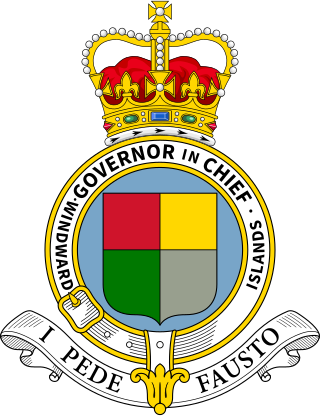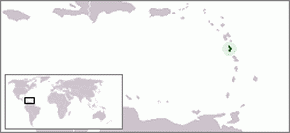
The Leeward Islands are a group of islands situated where the northeastern Caribbean Sea meets the western Atlantic Ocean. Starting with the Virgin Islands east of Puerto Rico, they extend southeast to Guadeloupe and its dependencies. In English, the term Leeward Islands refers to the northern islands of the Lesser Antilles chain. The more southerly part of this chain, starting with Dominica, is called the Windward Islands. Dominica was originally considered a part of the Leeward Islands, but was transferred from the British Leeward Islands to the British Windward Islands in 1940.
The Windward Islands are the southern, generally larger islands of the Lesser Antilles. Part of the West Indies, they lie south of the Leeward Islands, approximately between latitudes 10° and 16° N and longitudes 60° and 62° W.

The British West Indies (BWI) were colonised British territories in the West Indies: Anguilla, the Cayman Islands, Turks and Caicos Islands, Montserrat, the British Virgin Islands, Antigua and Barbuda, The Bahamas, Barbados, Dominica, Grenada, Jamaica, Saint Kitts and Nevis, Saint Lucia, Saint Vincent and the Grenadines, British Guiana and Trinidad and Tobago. Other territories included Bermuda, and the former British Honduras.

The coat of arms of Antigua and Barbuda was designed in 1966 by Gordon Christopher. It was officially introduced on 16 February 1967. The symbolism of the arms is more complex than that found on the flag of Antigua and Barbuda, but many elements are similar.

The flag of Montserrat consists of a Blue Ensign defaced with the British overseas territory's coat of arms. Adopted in 1960 to supplement the Union Jack after the dissolution of the British Leeward Islands the year before, it has been the flag of Montserrat since the territory was granted self-government that year. The design of the present flag entailed enlarging the coat of arms and outlining it with a white trim. Montserrat's flag is similar to the flags of eight other British Overseas Territories, which are also Blue Ensigns with their respective coats of arms.
This is a list of coats of arms of the United Kingdom, its constituent parts, Crown Dependencies and its Overseas Territories.

The term British West Indies refers to the former English and British colonies and the present-day overseas territories of the United Kingdom in the Caribbean.

The coat of arms of the British Virgin Islands consists of a green escutcheon (shield) charged with a woman in a white dress and gold-coloured sandals, holding a lit golden oil lamp and surrounded by eleven other golden lamps. Adopted shortly after the islands became a Crown colony, it has been the coat of arms of the British Virgin Islands since 1960. The escutcheon dates from the early 19th century and is featured on the flag of the territory. The woman and the lamps represent Saint Ursula and her companions, the namesake of the islands.

The coat of arms of Montserrat consists of an escutcheon (shield) charged with a woman in a green dress holding a golden harp and a black cross. In use since at least 1909, it has been the official coat of arms of the Caribbean island of Montserrat since the island became a British Crown colony in 1962. The escutcheon is featured on the flag of the territory.

The British Windward Islands was an administrative grouping of British colonies in the Windward Islands of the West Indies, existing from 1833 until 31 December 1959 and consisting of the islands of Grenada, Saint Lucia, Saint Vincent, the Grenadines, Barbados, Tobago, and Dominica, previously included in the British Leeward Islands.

The coat of arms of Dominica was adopted on July 21, 1961. It consists of a shield with two guardian sisserou parrots bracing the shield atop of which is a lion passant. The quarters of the shield depict a canoe, a banana tree, a palm and a frog of the native species known as the mountain chicken. Below the shield is the national motto: Apres Bondie C'est La Ter.

The coat of arms of Saint Kitts and Nevis was adopted in 1983 and possesses the motto "Country Above Self". The previous coat of arms, adopted in 1967 by the colony of Saint Christopher-Nevis-Anguilla, was nearly identical, except for coloration and the motto "Unity in Trinity".

The British Leeward Islands was a British colony from 1671 to 1958, consisting of the English overseas possessions in the Leeward Islands. It ceased to exist from 1816 to 1833, during which time it was split into two separate colonies. It was dissolved in 1958 after the separation of the British Virgin Islands, and the remaining islands became parts of the West Indies Federation.

The flag of the British Windward Islands was the flag of the Federal Colony of the Windward Islands. It was a Blue Ensign with the badge of the Governor-in-chief in the fly. The separate colonies under the Federal Colony each had their own ensigns. In 1903, the shape of the crown on the badge was changed slightly. The Governor-in-chief of the Windward Islands used a Union Flag defaced with the badge.

The flag of the British Leeward Islands was the flag of the Federal Colony of the Leeward Islands. It was a Blue Ensign with a badge. The colonies under the Federal Colony had their own badges from 1909. The Governor-in-chief of the Leeward Islands used a Union Flag defaced with the coat of arms.

The coat of arms of the Governor-in-chief of the British Windward Islands was adopted in 1886.

The following is an alphabetical list of topics related to the nation of Dominica.
The Leeward Islands Cricket Association, also known as the Leeward Islands Cricket Board, is the ruling body for cricket in the following Caribbean islands: Anguilla, Antigua and Barbuda, the British Virgin Islands, Montserrat, Nevis, Saint Kitts, Sint Maarten, and the United States Virgin Islands. Dominica is geographically a part of the Leeward Islands, but as it was part of the Windward Islands colony from 1940 until its independence, its cricket federation remains a part of the Windward Islands although it did participate in the first Leeward Islands tournament and was a founding member of the Leeward Islands Cricket Association in 1913.

This is a survey of the postage stamps and postal history of Dominica, an island nation in the Caribbean Sea. Claimed by France in the 17th century, it was later awarded to Great Britain, becoming independent in 1978.

The Tudor Crown, also known as the Imperial Crown, is a widely used symbol in the heraldry of the United Kingdom. In use officially from 1902 to 1953 and again from 2022, it represents both the British monarch personally and "the Crown", meaning the sovereign source of governmental authority. As such, it appears on numerous official emblems in the United Kingdom, British Empire and Commonwealth.
















